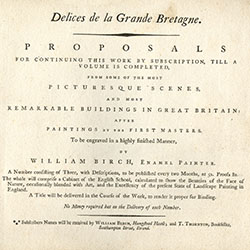 |
William Birch, Delices de la Grande Bretagne. Proposals for continuing this work by subscription, till a volume is completed (London, 1788-89). Library Company of Philadelphia. Gift of Charles P. Keates, Esq. on behalf of the Philadelphia Society for the Preservation of Landmarks (www.philalandmarks.org).
Birch made his reputation as a connoisseur of the picturesque with a very successful book of miniature engraved views of British landscape with the fashionable French title Les Delices de la Grande Bretagne. In this unique prospectus he established his claim to an important position in the community of British artists. The book was published in parts over several years, and this prospectus is bound with the first five parts, comprising 15 plates dated 1788 and 1789. |
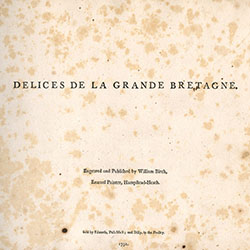 |
William Birch, Delices de la Grande Bretagne (London, 1791). Library Company of Philadelphia.
When Delices was finally published in 1791 it contained 36 plates. It had an elegantly understated title page, followed by a list of 240 subscribers, including Joshua Reynolds, Lord Mansfield, and many other aristocrats and patrons. |
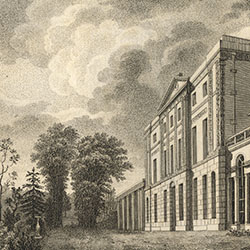 |
William Birch, The Garden Front of Kenwood the Seat of the Earl of Mansfield, in Delices de la Grande Bretagne (London, 1791). Engraving. Library Company of Philadelphia.
Delices clearly prefigured Birch’s Country Seats, with views of country houses and landscape scenes. Birch was a frequent guest at the grand country seat of his patron Lord Mansfield, which was near his own cottage on Hampstead Heath. |
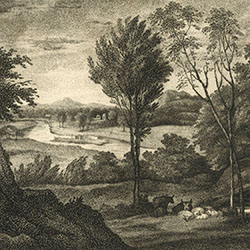 |
William Birch after Joshua Reynolds, View from Sir Joshua Reynolds’s House, Richmond Hill, in Delices de la Grande Bretagne (London, 1791). Engraving. Library Company of Philadelphia.
Birch included a copy of a Reynolds landscape of the view from his house in Delices as a tribute to his other great patron. |
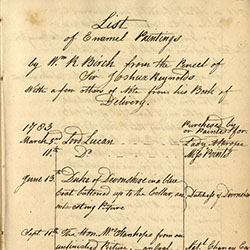 |
William Birch, List of Enamel Paintings by Wm. R. Birch from the Pencil of Sir Joshua Reynolds, manuscript, 1794? Library Company of Philadelphia.
Birch convinced Sir Joshua Reynolds to let him make enamel copies of his paintings, because Reynolds’s oil colors were known to fade in time, whereas Birch’s enamel colors would be pure and permanent. The Royal Academy had a rule against exhibiting copies, but Reynolds made an exception for Birch’s enamels because of their colors and also because he saw they were not mechanical copies but expressions of artistic genius. Birch’s catalog lists some 40 enamels resulting from this partnership between 1783 and 1794. He made multiple copies of some enamels, including fifteen of Lord Mansfield. |
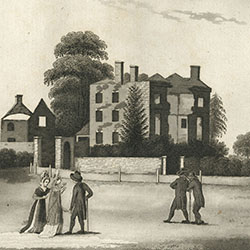
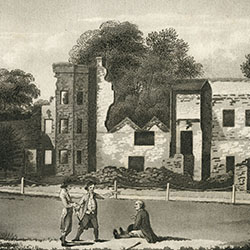
|
Philip Henry Witton, View of the Ruins of the Principal Houses destroyed during the Riots at Birmingham (London: J. Johnson, 1791). Aquatint. Library Company of Philadelphia.
These aquatint engravings were made to document the destruction of the houses of the leading Dissenters of Birmingham during a conservative working-class riot in 1791. The houses of Birch’s cousin William Russell and his friend the great chemist Joseph Priestley were among those ransacked. The two men decided to emigrate together to America, but Russell, who was in the good graces of the Jacobins, went to France instead, while Priestley and family went on to Philadelphia. |
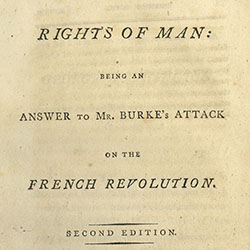 |
Thomas Paine, Rights of Man. Second edition (London: J.S. Jordan, 1791). Library Company of Philadelphia.
Birch claimed he did not know the famous radical Tom Paine (1737-1809), yet Paine subscribed for six copies of Delices. Birch was once cautioned against “spouting away upon” Paine’s scandalous defense of the French Revolution, The Rights of Man, by a friend who said, “these are dangerous times,” and if he talked that way in public, “he would be taken up.” At that moment Birch had in his possession 500 copies of Paine’s book! Mansfield pulled him aside to say “if anything should happen to you, mind you, send to me directly.” Paine was expelled from England. Birch may have been lucky to escape to America. |

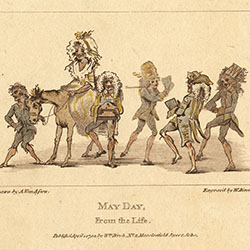
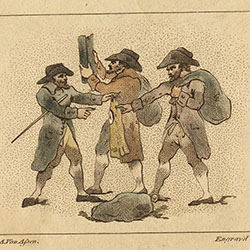
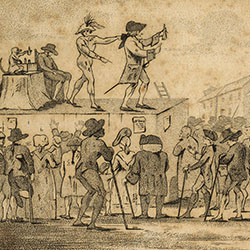
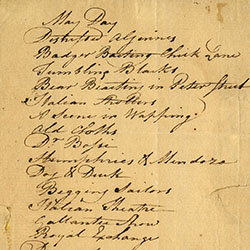
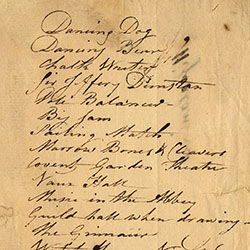
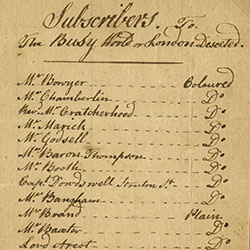
|
The Busy World. Library Company of Philadelphia
Just before he left for America, Birch began work on a series of Hogarthian satirical and humorous engravings called The Busy World, or London Dissected, based on drawings by Dutch- British artist Benedictus Antonio van Assen. They clearly anticipated the many vignettes of street life scattered throughout Birch’s later views of Philadelphia. Some were sold separately, hand-colored or plain, before and after he emigrated. This manuscript list of completed prints includes all the prints shown here, and another list of projected prints and a short list of subscribers found in his papers indicate that he was perhaps halfway through with this project when he abandoned it |
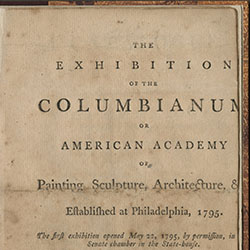

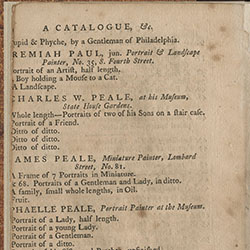
|
The Exhibition of the Columbianum, Philadelphia, 1795. Historical Society of Pennsylvania.
The Columbianum was a short-lived and fractious association of thirty professional and amateur artists that held an exhibition in 1795 in Independence Hall. Birch contributed a number prints and enamels, listed in this catalog, which he had brought with him from London. Three of them are exhibited here. He also listed work by his daughter Priscilla (“Miss Birch”) and his son Thomas (“Master Birch”). |
 |
William Birch, after William Hodges and Richard Cosway, View from Mr. Cosway’s Breakfast Room, Pall Mall, with the Portrait of Mrs. Cosway, from Delices de la Grande Bretagne (London, 1791). Hand-colored engraving. Library Company of Philadelphia.
Number 19 in the Columbianum catalog, “A specimen from a volume published by Mr. Birch,” was probably this engraving, beautifully hand-colored, from his Delices de la Grande Bretagne, which came down in the Birch family. It combined two paintings, the view over St. James’s Park by William Hodges (1744-1797), and the portrait of Maria Cosway (1760-1838) by her husband Richard (1742-1821). Both Cosways were well-known artists and socialites. In 1786 the recently widowed Thomas Jefferson fell in love with Maria, who encouraged him; but soon Jefferson’s slave Sally Hemmings joined him in Paris, and he switched his attentions to her. |
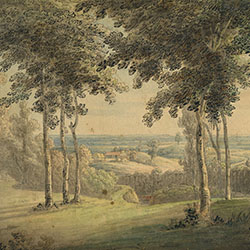 |
Robert Freebairn, Hampstead Heath, ca. 1785. Watercolor on paper. Library Company of Philadelphia.
Though not Birch’s work, this watercolor appears to be the one he exhibited at the Columbianum as “A view on Hamsted Heath near London (a drawing).” Perhaps he brought it over because he and his family were living on Hampstead Heath until their precipitous departure from London. |
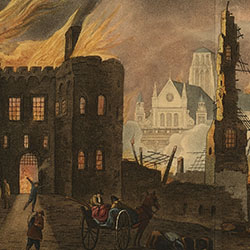 |
William Birch after Jan Griffier, The Great fire of London in the year 1666, ca. 1793. Hand colored engraving. Library Company of Philadelphia.
Shortly before he emigrated Birch made a copy of a Dutch painting of the ruins of the great fire of London for Thomas Pennant’s Some Account of London. This copy is dated 1807, so it is not the one that Birch exhibited in the Columbianum as “A colour’d print of the great fire of London.” This restrike was passed down in the Birch family. |
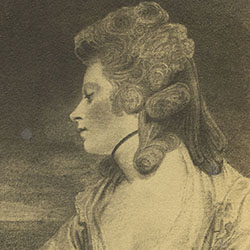 |
William Birch, Mrs. Robinson, 1784. Library Company of Philadelphia. Gift of the Birch Family.
Photographic reproduction of an engraving.
In 1784 Birch copied Sir Joshua Reynolds’ portrait of Mary Robinson, an actress and mistress of the Prince of Wales, both in engraving and enamel. The engraving was displayed at the Columbianum; this early 20th century photograph of it has been passed down in the Birch family. Reynolds said he would never wish his work better engraved. |






















